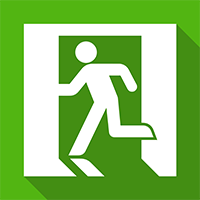-
 This course will give you an overview of epilepsy. It lists the methods of diagnosis, what a seizure is and how the brain can be affected. It will introduce some possible seizure triggers and describe what to do when someone has a seizure. It will also discuss some of the treatments offered to people with epilepsy and provide practical advice on what you can do if you witness someone having a seizure. Approved by CPD – Duration 30 mins*
This course will give you an overview of epilepsy. It lists the methods of diagnosis, what a seizure is and how the brain can be affected. It will introduce some possible seizure triggers and describe what to do when someone has a seizure. It will also discuss some of the treatments offered to people with epilepsy and provide practical advice on what you can do if you witness someone having a seizure. Approved by CPD – Duration 30 mins* -
 This course explains the difference between mental health and mental illness. It covers the symptoms of a number of the most common mental illnesses so you will know what to look out for or what to expect if you are working with someone with one of these conditions. As well as providing some practical advice on how you can work effectively with those affected by these conditions.
This course explains the difference between mental health and mental illness. It covers the symptoms of a number of the most common mental illnesses so you will know what to look out for or what to expect if you are working with someone with one of these conditions. As well as providing some practical advice on how you can work effectively with those affected by these conditions.Mental Health Awareness Course Modules
What is mental illness and prevalence rates Symptoms of Bi-Polar, depression, psychotic disorders and schizophrenia Symptoms of anxiety, personality disorder, self-harming Approved by CPD – Duration 25 mins* -
 Mental Health First Aid teaches participants how to notice and support individuals who may be experiencing mental health issues or exhibiting the signs of substance use in a work environment. They are also taught how to connect those people with appropriate help from fellow employees, community resources or healthcare professionals. Around 25 per cent of the UK population will experience a mental health problem at some point in their lives. Most are mild, tend to be short-term and are usually treated successfully with therapy and medication. But it is still a significant problem. Mental Health First Aid teaches participants how to notice and support individuals who may be experiencing mental health issues or exhibiting the signs of substance use in a work environment. They are also taught how to connect those people with appropriate help from fellow employees, community resources or healthcare professionals. The course introduces the subject and outlines the benefits of Mental Health first aid and workplace wellness schemes. It then goes on to cover the effects of stress on individuals and teams and discusses how stress and mental health are linked. It then covers the roles of employers, managers and employees in ensuring that a Mental Health First Aid programme is successful. It concludes with a series of practical examples of how to apply mental health first aid to real situations, how to support employees who are experiencing mental health issues and where to point them for further help and advice. Approved by Gatehouse Awards – Duration 90 mins*
Mental Health First Aid teaches participants how to notice and support individuals who may be experiencing mental health issues or exhibiting the signs of substance use in a work environment. They are also taught how to connect those people with appropriate help from fellow employees, community resources or healthcare professionals. Around 25 per cent of the UK population will experience a mental health problem at some point in their lives. Most are mild, tend to be short-term and are usually treated successfully with therapy and medication. But it is still a significant problem. Mental Health First Aid teaches participants how to notice and support individuals who may be experiencing mental health issues or exhibiting the signs of substance use in a work environment. They are also taught how to connect those people with appropriate help from fellow employees, community resources or healthcare professionals. The course introduces the subject and outlines the benefits of Mental Health first aid and workplace wellness schemes. It then goes on to cover the effects of stress on individuals and teams and discusses how stress and mental health are linked. It then covers the roles of employers, managers and employees in ensuring that a Mental Health First Aid programme is successful. It concludes with a series of practical examples of how to apply mental health first aid to real situations, how to support employees who are experiencing mental health issues and where to point them for further help and advice. Approved by Gatehouse Awards – Duration 90 mins* -
 Approved by Gatehouse Awards – Duration 30 mins*When people have good mental health, they are more likely to fulfil their potential. That means they enjoy work and cope easily with work situations. They have a happy family life and good social relationships. Organisations are required by law to promote and protect the mental well-being of their workforce. A comprehensive Mental Health Policy, along with easy-to-understand operating procedures, will incorporate mental health issues into established organisational thinking. It will make sure everyone knows how the organisation views and deals with workplace mental health. This online Developing a Workplace Mental Health Policy E-Learning course covers the steps that organisations should consider when developing and implementing a comprehensive workplace Mental Health Policy
Approved by Gatehouse Awards – Duration 30 mins*When people have good mental health, they are more likely to fulfil their potential. That means they enjoy work and cope easily with work situations. They have a happy family life and good social relationships. Organisations are required by law to promote and protect the mental well-being of their workforce. A comprehensive Mental Health Policy, along with easy-to-understand operating procedures, will incorporate mental health issues into established organisational thinking. It will make sure everyone knows how the organisation views and deals with workplace mental health. This online Developing a Workplace Mental Health Policy E-Learning course covers the steps that organisations should consider when developing and implementing a comprehensive workplace Mental Health PolicyDeveloping a Workplace Mental Health Policy Modules
Introduction Implementing a Workplace Mental Health Policy -
 At the end of this course, candidates will have an understanding of what a risk assessment is and how to complete one. To achieve this the course will define important terms, provide some basic background information to explain how important risk assessments are and discuss some of the legislation that applies. It will then go on to provide practical advice on how to identify hazards and analyse risk before finishing off by explaining the responsibilities of both employers and employees with regards to risk assessment. Approved by IIRSM & CPD- Duration 90 mins*
At the end of this course, candidates will have an understanding of what a risk assessment is and how to complete one. To achieve this the course will define important terms, provide some basic background information to explain how important risk assessments are and discuss some of the legislation that applies. It will then go on to provide practical advice on how to identify hazards and analyse risk before finishing off by explaining the responsibilities of both employers and employees with regards to risk assessment. Approved by IIRSM & CPD- Duration 90 mins* -
 The General Data Protection Regulation (GDPR) is designed to strengthen and unify data protection principles for all individuals within the European Union and the European Economic Area. The GDPR is an incredibly important change to data privacy regulations. Understanding its correct implementation is vital for all UK businesses and organisations, particularly for staff who regularly deal with personal data. This online Introducing GDPR E-Learning course is designed specially for those front line staff and provides a clear introduction to the main elements of the GDPR, including compliance and the consequences of non-compliance. The Introducing GDPR e-learning course explains the roles of key players – Data Protection Officers, Data Controllers, Data Protection Leads and Data Processors and covers the main categories of personal data, along with the six lawful bases for processing data, and how to audit the data your organisation holds. Other topics examined include the Seven Principles of the GDPR and the Eight Rights for Individuals, along with the importance of your Privacy Policy – how to construct one, and how to use it effectively when dealing with data subjects. Finally, there’s important information on data breaches; how to avoid them, what to do if one is discovered and how to file a breach report.
The General Data Protection Regulation (GDPR) is designed to strengthen and unify data protection principles for all individuals within the European Union and the European Economic Area. The GDPR is an incredibly important change to data privacy regulations. Understanding its correct implementation is vital for all UK businesses and organisations, particularly for staff who regularly deal with personal data. This online Introducing GDPR E-Learning course is designed specially for those front line staff and provides a clear introduction to the main elements of the GDPR, including compliance and the consequences of non-compliance. The Introducing GDPR e-learning course explains the roles of key players – Data Protection Officers, Data Controllers, Data Protection Leads and Data Processors and covers the main categories of personal data, along with the six lawful bases for processing data, and how to audit the data your organisation holds. Other topics examined include the Seven Principles of the GDPR and the Eight Rights for Individuals, along with the importance of your Privacy Policy – how to construct one, and how to use it effectively when dealing with data subjects. Finally, there’s important information on data breaches; how to avoid them, what to do if one is discovered and how to file a breach report.Introducing GDPR Modules
Introduction Data Processing Types of Data Data Subjects’ Rights Data Breaches Approved by CPD – Duration 60 mins* -
 In order to ensure that new and expectant mothers in early years provision and schools can work without unacceptable risks to their health and safety, employers must be aware of:
In order to ensure that new and expectant mothers in early years provision and schools can work without unacceptable risks to their health and safety, employers must be aware of:- any female workers who may be of child-bearing age
- the effects of the physiological, hormonal and psychological changes that occur during pregnancy and the postnatal nursing period
- any work activities, or aspects of the workplace, which may pose a particular risk to new and expectant mothers.
-
 Our Safeguarding Children Online Course has been created because, first and foremost, each and every one of us has basic human rights. Chief among these is the right to be healthy, happy and treated well, regardless of race, age, sex or location. When these rights are abused in some way, it’s wrong. Therefore, it is vital that guidelines, policies, and procedures are followed to enable everyone, without exception, to live a life in which these basic values and rights are maintained and upheld. Regardless of their age, sex, religion, ethnicity, or background, every child has the right to a healthy, happy life. Child safeguarding is about minimising and managing the risks to vulnerable individuals, particularly children. Although most children are brought up in loving, nurturing environments and grow up to lead happy lives, the subject has to be discussed to better protect those children who need it most. During this Online Safeguarding Children course you will hear many facts, figures and details surrounding the risk to children, the types of abuse suffered, how to recognise the signs of abuse and key safeguarding legislations put in place to minimise the abuse of children. Once you are able to recognise the signs of possible abuse, and know the steps you should take if you suspect it you will be better able to protect the children in your care. This Safeguarding Children Online Course is approved by leading industry body CPD
Our Safeguarding Children Online Course has been created because, first and foremost, each and every one of us has basic human rights. Chief among these is the right to be healthy, happy and treated well, regardless of race, age, sex or location. When these rights are abused in some way, it’s wrong. Therefore, it is vital that guidelines, policies, and procedures are followed to enable everyone, without exception, to live a life in which these basic values and rights are maintained and upheld. Regardless of their age, sex, religion, ethnicity, or background, every child has the right to a healthy, happy life. Child safeguarding is about minimising and managing the risks to vulnerable individuals, particularly children. Although most children are brought up in loving, nurturing environments and grow up to lead happy lives, the subject has to be discussed to better protect those children who need it most. During this Online Safeguarding Children course you will hear many facts, figures and details surrounding the risk to children, the types of abuse suffered, how to recognise the signs of abuse and key safeguarding legislations put in place to minimise the abuse of children. Once you are able to recognise the signs of possible abuse, and know the steps you should take if you suspect it you will be better able to protect the children in your care. This Safeguarding Children Online Course is approved by leading industry body CPDSafeguarding Children (Level 1) Course Modules
Introduction to Safeguarding Children Types of Abuse, who may carry it out and why children may not tell How to Recognise the Signs of Abuse What to do if you suspect a child is being abused Safeguarding Legislation Approved by CPD – Duration 75 mins* -
 Intelligence indicates that further terrorist attacks in our country are ‘highly likely’. Experience tells us that the threat comes not just from foreign nationals but from terrorists born and bred in Britain. Therefore, it is vital that our counter-terrorism strategy contains a plan to prevent radicalisation and stop would-be terrorists from committing mass murder. The Prevent strategy, published by the Government is part of the overall counter-terrorism strategy. This online Prevent Duty E-Learning Course starts with an overview of the Government’s Prevent strategy, and then looks at some of the reasons people become extremists. The Prevent Duty Online Course goes on to cover the objectives of the Prevent strategy, how to base your actions on a risk-based approach, what to do if you are concerned and much more. Introduction to the Course What is Prevent? Prevent Objectives Delivering Prevent with a Risk-Based Approach Extremism, Radicalisation and Terrorism What Should You Do If You Are Concerned? The Channel Process British Values Approved by CPD - Duration 65 mins*
Intelligence indicates that further terrorist attacks in our country are ‘highly likely’. Experience tells us that the threat comes not just from foreign nationals but from terrorists born and bred in Britain. Therefore, it is vital that our counter-terrorism strategy contains a plan to prevent radicalisation and stop would-be terrorists from committing mass murder. The Prevent strategy, published by the Government is part of the overall counter-terrorism strategy. This online Prevent Duty E-Learning Course starts with an overview of the Government’s Prevent strategy, and then looks at some of the reasons people become extremists. The Prevent Duty Online Course goes on to cover the objectives of the Prevent strategy, how to base your actions on a risk-based approach, what to do if you are concerned and much more. Introduction to the Course What is Prevent? Prevent Objectives Delivering Prevent with a Risk-Based Approach Extremism, Radicalisation and Terrorism What Should You Do If You Are Concerned? The Channel Process British Values Approved by CPD - Duration 65 mins* -

Working safely during COVID-19 requires all businesses to carry out an appropriate COVID-19 risk assessment. The assessment should directly address risks associated with coronavirus so that sensible measures can be put in place to minimise those risks for children, young people, adults and staff.
The FIVE steps to ensuring your Dance or Drama School is COVID-19 Secure
• Pay £72+ VAT for your Covid-19 Secure Risk Assessment below.
• Answer the comprehensive Covid-19 Secure questionnaire thoroughly and upload your School logo
• Receive the draft of your personalised Covid-19 Secure Risk Assessment within 5 working days
• Provide any comments or feedback if there are elements of the Covid-19 Secure Risk Assessment that you will struggle to comply with (ensuring that it will work for your School)
• Circulate the finalised Covid-19 Secure Risk Assessment to your staff, and make it available to students and parents
Following purchase please follow the link in your confirmation email and complete the Questionnaire. Your Covid-19 Risk Assessment will be emailed to you within 5 working days of submitting the Questionnaire.
-
Sale!

The Management of Health and Safety at Work Regulations 1999 requires all employers to undertake Risk Assessments appropriate to their business.
Our online Risk Management tool produces a comprehensive Dance or Drama School Production Risk Assessment (Wales) suitable for Dance or Drama schools staging a production in a local theatre or school hall in Wales and is written for the purposes of applying for your BOPA license, Child Performance license, meeting your Local Authority or Venue requirements.
- Manual Handling - lack of training and/or incorrect handling/lifting
- Production Vehicle Movement (loading/unloading)
- Viral Illnesses (where applicable)
- Complaint/Conflict with Public
- Criminal Activity
- Use of Tools
- Working at Height - Use of Ladders/Tallescope
- Working at Height - Falling objects / rigging failures
- Flown equipment such as cloths, frenchmen, LX and other performance related items (where applicable)
- Installation of ground supported LX and Sound
- Installation and use of electrical equipment
- Cable management – lack of
- Fire
- Emergency evacuation - failure to facilitate, obstructions etc
- Excessive Noise levels (>95dB)
- First Aid - lack of
- Welfare – lack of toilets or handwashing facilities
- Welfare – child performers
- The choreography of show - lack of, or inappropriate
- Lack of mental health support available
- Food - Biological
- Use of Haze or effect (where used)
Click below to purchase your Dance or Drama School Production Risk Assessment (Wales) Risk Assessment.
Following purchase please follow the link in your confirmation email and complete the Questionnaire.
Your Dance or Drama School Production Risk Assessment (Wales) will be emailed to you within 15mins of submitting the Questionnaire.

